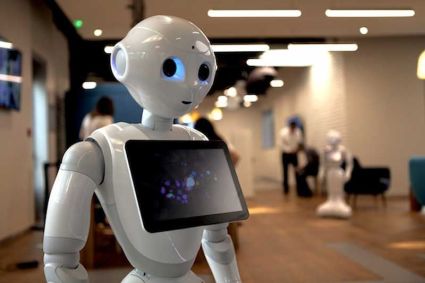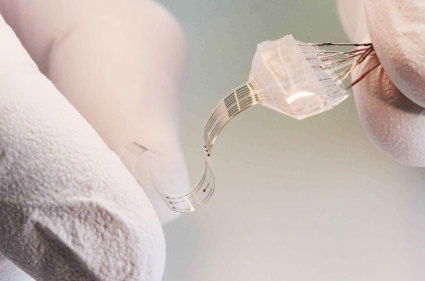
Robohub.org
Robohub Digest Jan. 2015: AI intrigue, SpaceX crash landing success, spinal cord implant

A quick, hassle-free way to stay on top of robotics news , our robotics digest is released on the first Monday of every month. Sign up to get it in your inbox.
Politics and intrigue
The New Year got off to political start, with robotics featuring high on the agenda for many world leaders this January. In his State of the Union address, US President Barack Obama spoke about how new technology can benefit the economy, specifically referring to the value of new robotic prosthetics and developments in space exploration, and encouraging Americans “to win the race for the kind of discoveries that unleash new jobs”. And at the World Economic Forum (WEF) in Davos, world leaders discussed the impact of robotics, AI and Big Data and their potential to disrupt the global economy.
While leaders were preparing to discuss AI at the WEF in the public eye, the Future of Life Institute (FLI) – a privately funded non-profit whose mission is to “mitigate existential risks facing humanity” – held a closed (some would say ‘secretive‘) conference in early January to discuss AI safety. The speakers roster was a who’s who list of tech and AI influencers, including Demis Hassabis, Thomas Dietterich, Erik Brynjolfsson, Nick Bostrom, Peter Norvig, Stuart Russell, and Elon Musk, and the goal of the conference was to identify promising research directions that will “maximize the future benefits of AI while avoiding pitfalls.” (The conference was closed to the media in order “to facilitate candid and constructive discussions”, however, some of the speaker’s presentations can now be found online here.) Following the conference, the FLI issued an open letter that outlined research priorities for robust and beneficial Artificial Intelligence. While the open letter itself seemed to illustrate a desire on the part of those working in AI to hold themselves to high ethical standards, it generated a flurry of hyped headlines from a jilted media that had been left to speculate in the vacuum. Days later, Elon Musk added to the media frenzy by donating $10 million to fund a global research program aimed at keeping AI beneficial to humanity, and Tom Dietterich and Eric Horvitz of the Association for the Advancement of Artificial Intelligence (AAAI) published an article discussing the risks of advancements in AI, arguing that “we must not put AI algorithms in control of potentially-dangerous systems until we can provide a high degree of assurance that they will behave safely and properly”. Meanwhile, Lee Gomes wrote that the Turing test is not robust enough to test the intelligence of computer programmes and welcomed the efforts by a group of roboticists now looking into alternatives.
Lifting the AI veil
With all the AI intrigue afoot, it’s refreshing to note that January also brought forth two new efforts to demystify the topic. Robohub’s newest syndicated podcast, Talking Machines, will be bringing listeners clear conversations with experts in the field of AI. Since kicking off on January 1, the podcast has featured interviews with Ilya Sutskever, who thinks that a little bit of magical thinking is crucial to work in AI, and Kevin Murphy, who spoke about how to learn about machine learning. Look for new episodes every other Thursday.
The AAAI video competition was also held this month in Austin, Texas, to spread the word about research and applications in AI through exciting educational videos. The Best Video award went to the Cowriter Project, an initiative through which children learn to write by teaching a robot to write.
Other winners included a video about adaptive learning through a Mario game (People’s Choice Award) and a video about self-organising collective decisions in swarms (Best Student Video).
Re-usable space tech: One step closer
This month, SpaceX’s 7th Dragon mission successfully sent another spacecraft to dock with the International Space Station (ISS) – the fifth successful dock under NASA’s CRS program. More remarkable was SpaceX’s ambitious attempt to return the first stage of the Falcon9 rocket back to earth. The rocket performed a successful re-orientation maneuver and controlled decent, and almost landed as intended on an unmanned ocean barge. Unfortunately the rocket lost control – possibly due to insufficient hydraulic fluid – just before the final touchdown and was lost at sea. Although the project did not achieve its ultimate goal of a safe landing, SpaceX CEO Elon Musk hailed the mission an overall success.
In other space-related news, NASA teamed up with Nissan for a robocar project, seeking to a zero-emission self-driving car, and announced that it is planning to build a helicopter scout to travel aboard the next Mars rover, in order to help explore and map the Red Planet.
Future thinking
If the new year is a time for resolutions, it is also a time for looking ahead, and many have been tempted to name 2015 “The Year of the Robot”. This is what MIT Mechanical Engineering Professor John Leonard discussed on Bloomberg Business this month, addressing issues such as Google’s secret robot plan and the regulation of drones.
Meanwhile, Peter Diamandis published his eleven top tech picks for 2015, including virtual reality, 3D printing and drones. Similarly, Raffaello D’Andrea shared his views on robotics’ past and what developments in robotics we might expect to see in the future.
Consumer Electronics Show (CES)
January also saw this year’s CES, which boasted an exciting range of new gadgets and inventions, including a Mercedes concept car and several demos of supervised traffic jam assist. Also notable was the variety of drones at CES, including self-flying, personal camera and follow-me drones, and the drone rodeo was one of the show’s most exciting events.
Yet while drones, robocars and consumer electronics were certainly exciting, according to a Fortune survey, what users are really looking for is longer battery life. The reason? Gadgets are great, but they would be so much more fun if you didn’t have to charge them every few hours.
Social robotics
Personal robots could rival drones and robocars as the autonomous tech to watch for in 2015. Two of the first personal robots are set to go on sale soon, including a new low-tech “baby robot” designed to curb loneliness in senior citizens, and Pepper the robot, which goes on sale in Japan in February.
While social robotics will be tested in the marketplace this year, several challenges remain. One of these is the refinement of speech, as natural language is the key interface paradigm for social robotics. Another challenge will in be developing social and regulatory norms around how much interaction with robots is safe and acceptable. As we introduce social robots into our lives, we will have to figure out what kind of relationships we want with them.
Business and government
In the world of business, The Robot Report looked back on 30 fundings, acquisitions, IPOs and failures of 2014, providing figures and statistics to understand last year’s robotics market. Despite a few setbacks, investment in robotics was booming overall, with more than $1 billion in acquisitions and $100 million in IPOs. Several new funding announcements were also made in January.
Looking forward, China predicts forty per cent annual growth in their robotics market and US-based Rethink Robotics got a $26.6 million Christmas gift to ensure that its operations can continue. Also in the US, iRobot founded a new venture capital firm and Ford is opening a new 25,000 sq ft Research and Innovation Center in Palo Alto, creating new jobs for 125 researchers, engineers and scientists. In the EU, governments have now invested $87 million for European robotic projects under Horizon 2020. However, this kind of support may now reduce as European Commission President Jean-Claude Juncker proposed legislation to pay for economic stimulus using funds previously allocated to scientific research.
The rise of the drone

More than a dozen agents searching WH north lawn, w/ flashlights into the bushes. Source: Nedra Pickler.
As things are looking up for most robotics markets around the world and drones are quickly becoming one of the most sought after consumer products, it’s no wonder then that Scott Mayerowitz compared today’s drone market to Silicon Valley in its early days, suggesting that drones will soon become a permanent fixture in our lives.
The FAA, the body that has been looking at drone regulation in the US, granted two further exemptions for commercial drone use, for real estate and agricultural crop scouting. The organisation had also found a journalist who used a drone to film a car crash last year not guilty of recklessness, a fact only recently revealed through a FOIA request filed by Conneticut television station FoxCT. These events may indicate that things are moving forward in the hotly debated area of drone regulation – we may be on our way to further exemptions and clearer rules in 2015.
Despite the forward movement, a quadrocoper crashed onto the White House this month, bringing the issue of drone safety and regulation to the forefront once again.
Meanwhile in the lab…
A team from EPFL and NCCR Robotics in Switzerland working on a spinal cord implant to treat paralysis have reported on a major breakthrough, publishing proof that their device, the e-dura implant, is viable for months in animals. The team is now moving on to the next stage of research, which will involve testing of the implant in human subjects.
In other research news, a team from the University of Maryland and NICTA, Australia, is teaching robots how to cook by showing them YouTube videos of cooking shows.
Robotainment
2015 is promising to be a big year for entertainment with, by and about robots. The latest in a series of movies tackling robot-related topic is a feel-good Hollywood movie called Spare Parts, about a group of young immigrants who against all odds win a major US robotics contest. While the movie concludes on a happy note, the real life ending is less positive, as highlighted in the NY times by the story’s author.
In other robotainment news, CBC launched a new documentary called Robotize Me, which explores our desire to develop intelligent and emotional machines. It turns out that Roboticize me is co-hosted by RoboThespian, which was just featured this month on the Robots Podcast.
Events to watch for in February
- The Unmanned Systems Expo TUSEXPO – Feb. 4-6, The Hague, Netherlands
- World Ag Expo – Feb. 10-12, Tulare, CA
- ATX Automation Technology West Trade Show – Feb. 10-12, Anaheim, CA
- RE.WORK Internet of Things Meetup – Feb 18, 2015, London, UK
- Intl Expert Days Service Robotics – Feb. 26-27, Laufin, Germany
tags: Robohub Digest












